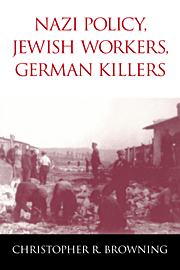Book contents
- Frontmatter
- Contents
- Introduction
- Map of Poland
- 1 From “Ethnic Cleansing” to Genocide to the “Final Solution”: The Evolution of Nazi Jewish Policy, 1939–1941
- 2 Nazi Policy: Decisions for the Final Solution
- 3 Jewish Workers in Poland: Self-Maintenance, Exploitation, Destruction
- 4 Jewish Workers and Survivor Memories: The Case of the Starachowice Labor Camp
- 5 German Killers: Orders from Above, Initiative from Below, and the Scope of Local Autonomy – The Case of Brest–Litovsk
- 6 German Killers: Behavior and Motivation in the Light of New Evidence
- Postscript
- Index
4 - Jewish Workers and Survivor Memories: The Case of the Starachowice Labor Camp
Published online by Cambridge University Press: 22 March 2010
- Frontmatter
- Contents
- Introduction
- Map of Poland
- 1 From “Ethnic Cleansing” to Genocide to the “Final Solution”: The Evolution of Nazi Jewish Policy, 1939–1941
- 2 Nazi Policy: Decisions for the Final Solution
- 3 Jewish Workers in Poland: Self-Maintenance, Exploitation, Destruction
- 4 Jewish Workers and Survivor Memories: The Case of the Starachowice Labor Camp
- 5 German Killers: Orders from Above, Initiative from Below, and the Scope of Local Autonomy – The Case of Brest–Litovsk
- 6 German Killers: Behavior and Motivation in the Light of New Evidence
- Postscript
- Index
Summary
Between early December 1941, when the Nazis opened the first death camp at Chelmno in the Warthegau, and mid-February 1943, when the ghetto-clearing units had completed the last stage of their initial sweep of the Polish ghettos, the vast bulk of Polish Jewry was destroyed. Aside from those who had made good their escape to the east, about 300,000 Polish Jews remained alive under German control in various work camps and so-called remnant or work ghettos. The temporary survival of this remnant of Polish “work Jews,” while mollifying to those primarily concerned with German war production and the growing shortage of labor, was not pleasing to Heinrich Himmler. Between the spring and fall of 1943, he labored furiously and with considerable success to murder the Polish “work Jews” as well. By late November 1943 the remnant ghettos of eastern Poland, especially Warsaw and Bialystok, as well as the labor camps of the districts of Galicia and Lublin, had, with minuscule exceptions, all been destroyed.
This elimination of these “work Jews” was not, I must emphasize, achieved through what the Nazis euphemistically termed “destruction through labor.” For the most part, the victims were not gradually worked and starved to death. Rather, the workers in these camps and remnant ghettos were killed in a relentless campaign of systematic mass murder, exemplified above all by the great Erntefest or “harvest Festival” massacre of 42,000 “work Jews” in the Lublin district in a mere 2 days on November 3–4, 1943.
- Type
- Chapter
- Information
- Nazi Policy, Jewish Workers, German Killers , pp. 89 - 115Publisher: Cambridge University PressPrint publication year: 2000



